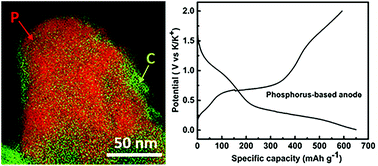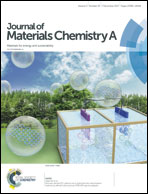High capacity potassium-ion battery anodes based on black phosphorus†
Abstract
Potassium-ion batteries are a new class of high voltage electrochemical energy storage cells that may potentially complement or replace lithium-ion batteries in many applications. Graphite is considered as a prospective anode material for these batteries but its demonstrated capacity is only 270 mA h g−1. This manuscript studies a novel type of nanocomposite anodes based on black phosphorus as their main active component, with a much higher capacity in potassium-ion batteries. These anode materials are able to deliver a first cycle capacity as high as 617 mA h g−1, more than twice the capacity of graphite in potassium cells. Quick depotassiation is achievable in the electrodes under certain conditions. Based on the data of X-ray diffraction analysis, it is proposed that black phosphorus operates via an alloying–dealloying mechanism with potassium and the end product of the electrochemical transformation is a KP alloy (implying a theoretical capacity of 843 mA h g−1 for phosphorus in potassium cells). This work emphasizes the feasibility of potassium-ion battery anode materials with high gravimetric capacities, comparable with those of high capacity anode materials for lithium-ion and sodium-ion batteries.

- This article is part of the themed collection: Journal of Materials Chemistry A Emerging Investigators


 Please wait while we load your content...
Please wait while we load your content...